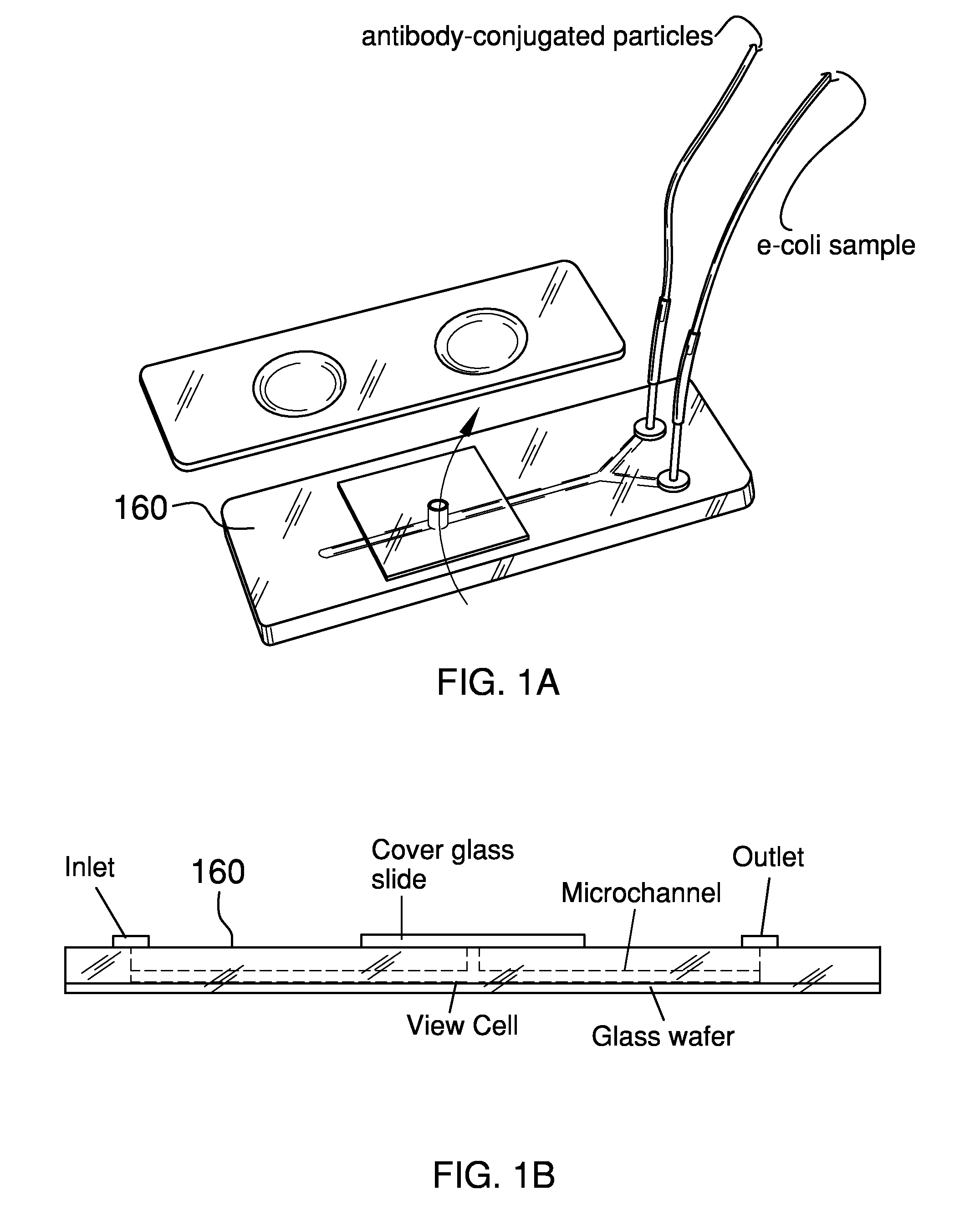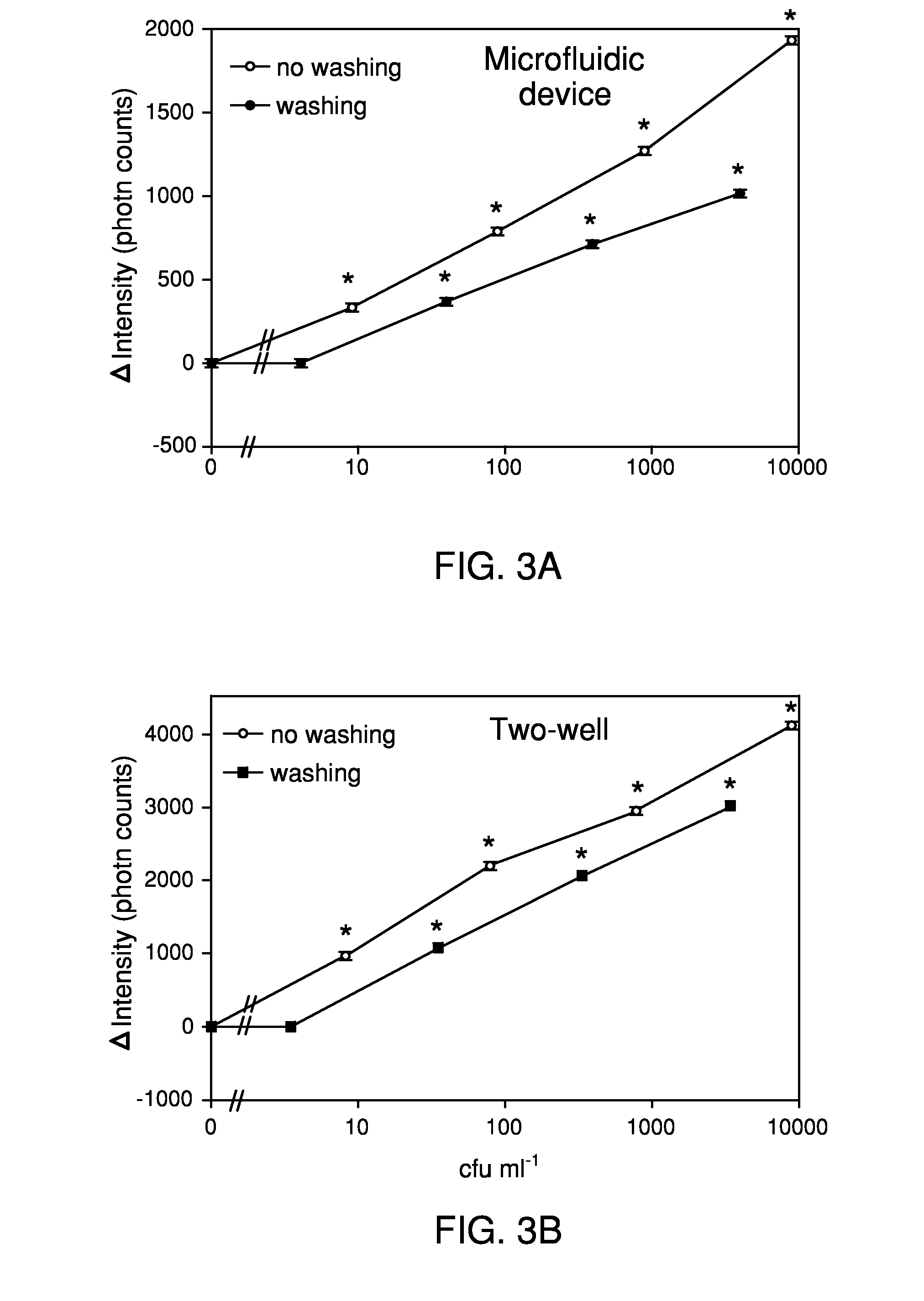Devices And Methods For Detection Of Microorganisms
a microorganism and detection method technology, applied in the field of microorganism detection methods and devices, can solve the problem of time-consuming
- Summary
- Abstract
- Description
- Claims
- Application Information
AI Technical Summary
Benefits of technology
Problems solved by technology
Method used
Image
Examples
example 1
Conjugation of an Antibody
[0060]The following is an example of conjugating an antibody. The present invention is not limited to this example. One (1) ml of 0.02% (w / v) 0.92-μm highly carboxylated polystyrene (HOPS) particles (e.g., 10 carboxyl groups per 1 nm2 particle surface; Bangs Laboratories, Fishers, Ind.) can be conjugated with 1 ml of 1.023 μg / ml anti-E. coli (e.g., polyclonal antibody developed in rabbit; catalog number ab13626; Abcam, Cambridge, Mass.) via physical adsorption. Surface coverage of antibodies to particles may be about 33%.
example 2
Culturing of Escherichia coli
[0061]The following is an example of culturing Escherichia coli. The present invention is not limited to this example. E. coli K-12 lyophilized cell powder (Sigma-Aldrich catalog number EC1) can be cultured in media, for example brain heart infusion broth (Remel, Lenexa, Kans.), at about 37° C. for about 20 h. The grown cell culture of lyophilized E. coli K-12 can be serially diluted with 10 mM PBS (pH 7.4) by 10−5 to 10−8. As the lyophilized powder of E. coli K-12 may contain dead cell fragments and free antigen, the diluted E. coli K-12 solutions can be washed by centrifuging at about 2000 g for about 15 min, followed by elimination of supernatants and resuspension in PBS. This centrifugation-resuspension can be repeated (e.g., 3 times) to help ensure complete removal of dead cell fragments and free antigens.
[0062]A viable cell count can be performed by planting dilutions (e.g., abut 200 μl) to eosin methylene blue agar (DIFCO, Lawrence, Kans.) and in...
example 3
Fabrication of a Microfluidic Device
[0063]The following is an example of fabrication of a microfluidic device according to the present invention. The present invention is not limited to this example. Microfluidic devices can be fabricated via standard soft lithography with a polydimethyl siloxane (PDMS) molding technique (well known to one of ordinary skill in the art). An example of a layout of a Y-shaped microfluidic device is shown in FIGS. 1A and 1B. The microfluidic device may comprise a slide (e.g., PDMS slide) with a first inlet (e.g., well) and a second inlet (e.g., well). The inlets (e.g., first inlet / well, second inlet / well) may be constructed to have a dimension of about 200 μm (width)×100 μm (depth) as measured by a profilometer (Alpha Step 2000, Tencor Instruments, Reston, Va.). In some embodiments, the inlets / wells may be constructed to have other dimensions.
[0064]In some embodiments, a second slide (e.g., PDMS slide) can be used as a cover in order to get a sufficient...
PUM
 Login to View More
Login to View More Abstract
Description
Claims
Application Information
 Login to View More
Login to View More - R&D
- Intellectual Property
- Life Sciences
- Materials
- Tech Scout
- Unparalleled Data Quality
- Higher Quality Content
- 60% Fewer Hallucinations
Browse by: Latest US Patents, China's latest patents, Technical Efficacy Thesaurus, Application Domain, Technology Topic, Popular Technical Reports.
© 2025 PatSnap. All rights reserved.Legal|Privacy policy|Modern Slavery Act Transparency Statement|Sitemap|About US| Contact US: help@patsnap.com



